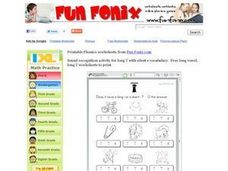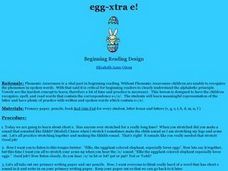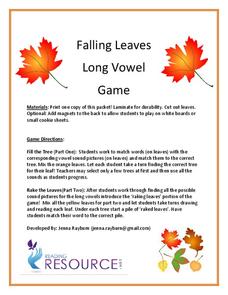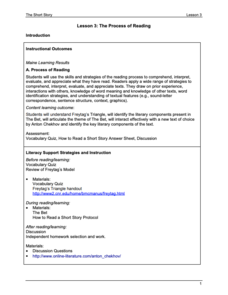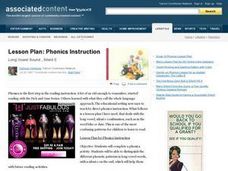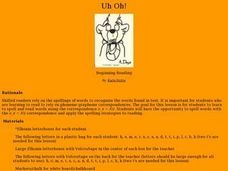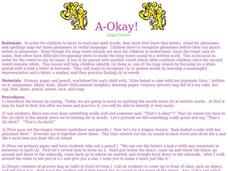Curated OER
Does it Have a Long I or a Short I
In this phonics worksheet, students say the name of each of twelve pictures. They identify circle either the long i or short i symbol to tell which sound is in the picture.
Curated OER
Sound Recording Analysis Worksheet
In this sound recording worksheet, students analyze a recording. Using this checklist students complete 2 multiple choice and 10 short answer question about a specific recording.
Curated OER
Say What?
Students explore phonemes in spoken words. They discuss the /e/ (short e) correspondence. Students read "Red Gets Fed." They learn a meaningful letter symbol for the /e/. Students identify /e/ sound in both spoken and written words.
Curated OER
Exciting E's "/e/...what did you say?" Exicing E's!
Students recognize the short /e/ sound in spoken and written words. They say a tongue twister which emphasizes words with the short /e/ sound. They then listen to the story "Red Gets Fed" and identify the words in the story with the...
Curated OER
What's Behind the Creaky Door?
First graders are introduced to the concept that letters stand for the mouth moves that we make when sounds are made. They practice making the /e/ sound and compare it to the sound a creaky door makes and then try saying the tongue...
Curated OER
What Begins with the Letter E?
In this letter recognition worksheet, students draw lines to match pictures that begin with the short vowel sound of the letter E or e to a box labeled as such. They choose between 6 pictures that include an elephant, eggs, and a bird.
Curated OER
DIGITAL WATERWORKS
Students add digitally-produced, water sound effects to a song, using electronic keyboards.
Curated OER
Egg-xtra E!
First graders recognize the short vowel e in written and spoken language. Through listening activities, they discriminate the vowel sound /e/ from other phonemes. Students identify the phoneme and letter in words and sentences they write.
Curated OER
Home Spelling Practice: Syllabication Patterns: Short Vowels
In this spelling activity, students learn to spell a list of 20 words. All words have short vowel sounds with two or three syllables. Students write each word one time on the lines. There are additional at-home spelling activities...
Reading Resource
Falling Leaves Long Vowel Game
Autumn's come early in your classroom! Match leaves with short words to the trees with the correct vowel sounds. A few blank leaves allow you to add your own words to the activity.
Meadows Center for Preventing Educational Risk, University of Texas at Austin
Lesson 5 - R-Controlled Syllables
Put on your pirate hat and get ready to teach r-controlled syllables. Learners practice using words that contain ar, or, er, ir, and ur. Instructors model how to decode words to isolate vowel teams, as well as combine r-controlled sounds...
Maine Content Literacy Project
The Process of Reading vocabulary, literary elements
Cover Freytag's Triangle and examine Anton Chekhov's "The Bet" in this third lesson plan in a series of fourteen based around short stories. Learners take a quiz and discuss Freytag's triangle. They apply the triangle to "The Bet" and...
Maine Content Literacy Project
Introduction to The Lottery, by Shirley Jackson
"The Lottery" by Shirley Jackson is a great story to share with your class, and this instructional activity focuses on just that story! The eighth in a fourteen-instructional activity series on short stories, the plan has learners...
Maine Content Literacy Project
Introduction to John Updike
Expand your pupils' understanding of the short story genre with a study of John Updike and his story "A&P." This lesson, the fourth in a series of fourteen, invites learners to examine literary terms and read and discuss the story....
Maine Content Literacy Project
Introduction to Ernest Hemingway
What is a white elephant, and what does it have to do with Ernest Hemingway? Study "Hills Like White Elephants" in-depth by following the procedures outlined in this lesson, the fifth in a series of fourteen. Learners start the day with...
K5 Learning
The Day I Tried to Cook
First graders read a short story on cooking. Then they respond to questions based on interest and practice writing.
Curated OER
Phonics Instruction: Long Vowel Sound, Silent E
Students explore language arts by participating in a class word identification game. In this phonics instructional activity, students read several words in class and identify the different sounds between short and long vowel words....
Curated OER
Uh Oh!
Help your elementary learners distinguish between short and long vowel /o/ sounds. They are introduced to the vowel-consonant-e pattern that changes short vowel sounds into long vowel sounds. Then they practice reading and spelling words...
Curated OER
A-Okay
Learners distinguish between short and long vowel /a/ sounds. They are introduced to the vowel-consonant-e pattern that changes short vowel sounds into long vowel sounds. Then they practice identifying words with the...
Curated OER
Sound Spelling
Practice how to change words by switching out letters that make different sounds with youngsters. The teacher encourages spellers to, "Think of words that rhyme with "bug." As the kids come up with words like, "rug," "tug," and "mug,"...
Curated OER
Everyone is Reading
Young scholars study /e/ in both written and spoken words using a tongue twister and letterbox activities. They recite a tongue twisters and make words using letterboxes. Next, they read "Red Gets Fed" and find words that contain the /e/...
Curated OER
Vowel Change of Short E
In this language arts worksheet, students look for the pattern for changing the vowel "E" into the right form for writing the words in the Latin language.
Curated OER
School-Home Links: Sounds in Short Words
In this word sounds worksheet, students point to each word and say it slowly. Family members repeat the word and then ask the children to name the sounds.
Curated OER
Scanning Worksheet-Catullus 58
Your advanced Latin learners mark the metrical pattern in Catullus 58, a poem written by Catullus concerning his love and hatred of Lesbia. Spend time translating the poem so your learners have a complete understanding of the passage.
